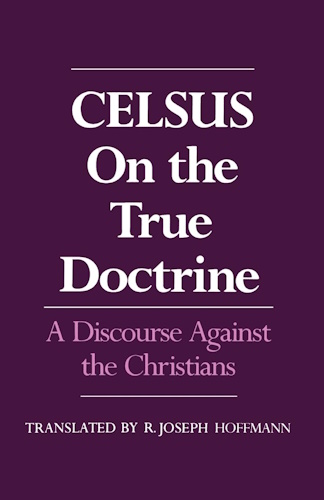

On the True Doctrine: A Discourse Against the Christians

The works of many early critics of the Christian church were burned by ruling emperors or otherwise destroyed in the second and third centuries, but the writings of the Greek pagan philosopher, Celsus, have survived indirectly through his eloquent opponent Origen of Alexandria. In his apologetical treatise, Contra Celsum, Origen argues against the ideas set forth by Celsus and quotes from Celsus' The True Doctrine at length. Through this treatise, Celsus has come to represent the detached pagan voice of the ages. In this translation, Professor Hoffmann has, for the first time, painstakingly reconstructed the main order of the philosopher's argument. Celsus' discourse shows him to be an eclectic philosopher--a dabbler in various schools of thought, including Platonism and Stoicism, and a student of the history and religious customs of many nations. Hoffman supplements this definitive translation with an informative introduction, summarizing Celsus' premises and placing the identity of Celsus in its historical context.
Paperback: 160 pages
Publisher: Oxford University Press; 1/20/87 edition (February 19, 1987)
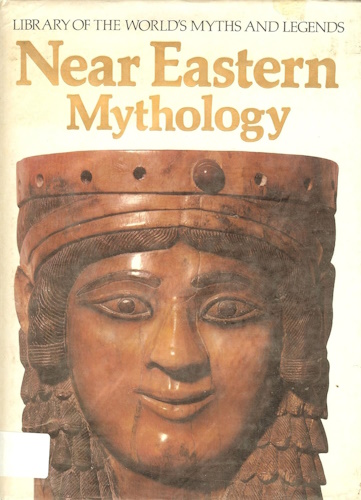

Near Eastern Mythology (Library of the World's Myths and Legends)

Discusses the religion and mythology of Mesopotamia, Canaan, and Israel.
Series: Library of the World's Myths and Legends
Hardcover: 144 pages
Publisher: Peter Bedrick Books; Revised edition (March 1, 1985)
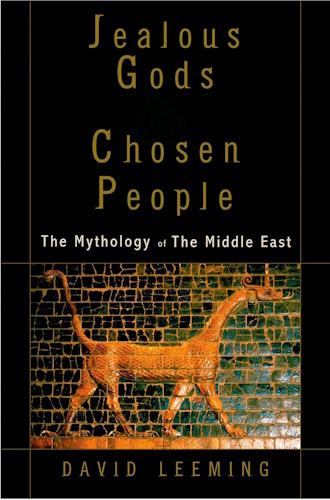

Jealous Gods and Chosen People: The Mythology of the Middle East

Here, David Leeming offers the first comprehensive narrative study of the mythology of the Middle East. Leeming offers an in-depth discussion of the mythology of the region, covering individual pantheons, cosmic myths, mythic heroes, and much more. He ranges from prehistoric figures such as the Mother Goddess of Çatal Hüyük to Mesopotamian gods such as Marduk and mythic heroes such as Gilgamesh, to the pantheon of Egyptian mythology, including the falcon-headed sky-sun god Horus and jackal-headed Anubis. The author also offers an illuminating exploration of the mythology of the three great monotheistic religions of the region: Judaism, Christianity, and Islam. In a provocative Epilogue, Leeming notes that fundamentalists in the area's three religions all see their way as the only way, forgetting that myths represent truths that are spiritual and philosophical--not historical events that can be used to justify acts of violence. With key maps, illustrations, bibliography, and index, Jealous Gods and Chosen People provides an inclusive, authoritative, and captivating account of a mythology that remains a potent--and often destructive--force in the world today.
About the Author
David Leeming is Emeritus Professor of English and Comparative Literature at the University of Connecticut. His many books include Myths, Legends, and Folktales of America, with Jake Page, A Dictionary of Asian Mythology and Myth: A Biography of Belief. He lives in Riverdale, New York.
Paperback: 160 pages
Publisher: Oxford University Press (June 2, 2005)
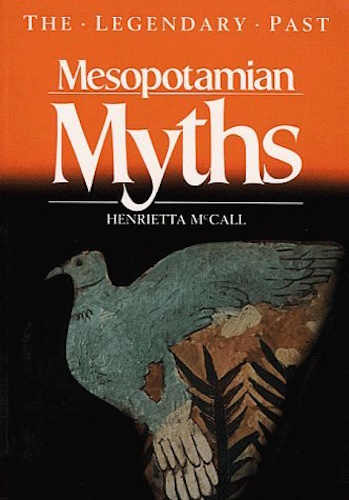

Mesopotamian Myths (Legendary Past Series)

Briefly describes the rediscovery and decipherment of the Mesopotamian myths and legends, introduces and retells the Epic of Gilgamesh, and others, and examines their importance, both past and present
Series: Legendary Past Series
Paperback: 80 pages
Publisher: University of Texas Press; 1 edition (1990)
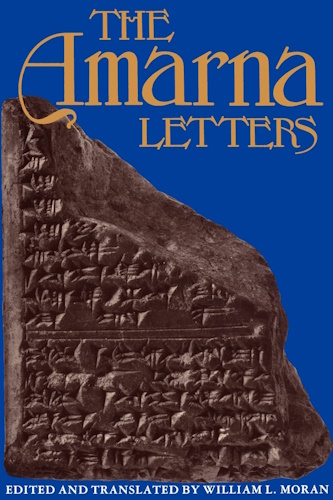

An ancient inscription identified some of the ruins at el Amarna as "The Place of the Letters of the Pharaoh." Discovered there, circa 1887, were nearly four hundred cuneiform tablets containing correspondence of the Egyptian court with rulers of neighboring states in the mid-fourteenth century B.C. Previous translations of these letters were both incomplete and reflected an imperfect understanding of the Babylonian dialects in which they were written. William Moran devoted a lifetime of study to the Amarna letters to prepare this authoritative English translation. The letters provide a vivid record of high-level diplomatic exchanges that, by modern standards, are often less than diplomatic. An Assyrian ruler complains that the Egyptian king's latest gift of gold was not even sufficient to pay the cost of the messengers who brought it. The king of Babylon refuses to give his daughter in marriage to the pharaoh without first having proof that the king's sister―already one of the pharaoh's many wives―is still alive and well. The king of Karaduniyash complains that the Egyptian court has "detained" his messenger―for the past six years. And Egyptian vassal Rib-Hadda, writing from the besieged port of Byblos, repeatedly demands military assistance for his city or, failing that, an Egyptian ship to permit his own escape.
Paperback: 448 pages
Publisher: Johns Hopkins University Press (October 31, 2000)
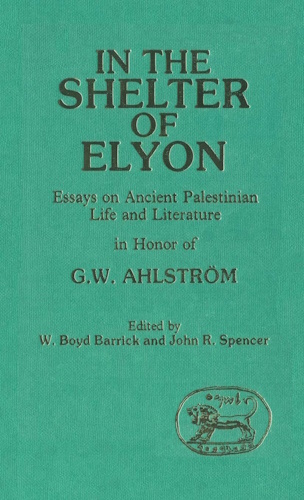

In the Shelter of Elyon: Essays on Ancient Palestinian Life and Literature (Journal for the study of the Old Testament)

This magnificent collection of articles on OT literature, history, religion and culture comprises the following studies: A.L. Merrill and J.R. Spencer, 'The Uppsala School' of Biblical Studies. W. Boyd Barrick, G.W. Ahlström in Profile. B. Glazier-McDonald, G.W. Ahlström: A Bibliography. W. Boyd Barrick and J.R. Spencer, Parentheses in a Snowstorm: G.W. Ahlström and the Study of Ancient Palestine. P.A.H. de Boer, Psalm 81.6a: Observations on Translation and Meaning of One Hebrew Line. N.C. Habel, The Role of Elihu in the Design of the Book of Job. C.E. L'Heureux, The Redactional History of Isaiah 5.1-10.4. D. Pardee, The Semantic Parallelism of Psalm 89. J. Van Seters, Joshua 24 and the Problem of Tradition in the Old Testament. M. Haran, The Shining of Moses' Face: A Case in Biblical and Ancient Near Eastern Iconography. A.S. Kapelrud, The Prophets and the Covenant. M. Ottosson, The Prophet Elijah's Visit to Zarephath. B. Otzen, Heavenly Visions in Early Judaism: Origin and Function. A.W. Sjöberg, Eve and the Chameleon. G. Widengren, Yahweh's Gathering of the Dispersed. P.R. Ackroyd, The Biblical Interpretation of the Reigns of Ahaz and Hezekiah. S. Herrmann, King David's State. S.A. Kaufman, A Reconstruction of the Social Welfare Systems of Ancient Israel. T.W. Overholt, Thoughts on the Use of Charisma in Old Testament Studies. J.M. Sasson, The Biographic Mode in Hebrew Historiography.
Series: Journal for the study of the Old Testament (Book 31)
Hardcover: 330 pages
Publisher: Sheffield Academic Press (October 1, 1984)
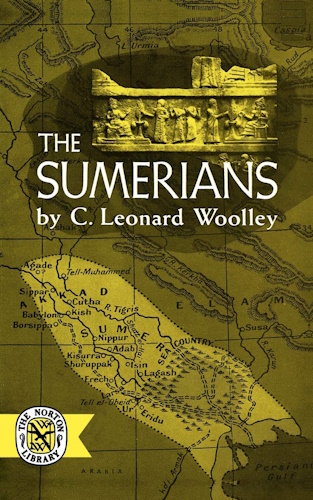

The Sumerians (Norton Library (Paperback))

In this book Professor Woolley, one of the world's foremost archaeologists, shows quite clearly that when Egyptian civilization began the civilization of the Sumerians had already flourished for at least 2,000 years.
The idea that Egypt was the earliest civilization has been entirely exploded. The Sumerians had reached a very high level of culture by 3500 B.C.E., and may be said with some justice to be the forerunners of all the Old World civilizations of Egypt, Assyria, Asia Minor, Crete, and Greece. This book will appeal to everyone interested in the early history of humankind.
About the Author
Sir Charles Leonard Woolley, as leader of the joint expedition of the University of Pennsylvania Museum and the British Museum, directed important excavations on the site of Ur of the Chaldees, a famous city long buried in the desert sand of Mesopotamia.
Series: Norton Library
Paperback: 198 pages
Publisher: W. W. Norton & Company (September 17, 1965)


The Devils and Evil Spirits of Babylonia

The object of the two volumes which form the present work is to supply the student of Assyrian Demonology withE nglish transliterations and translations, with the necessary notes, etc., of the documents printed in the Sixteenth and Seventeenth Parts of Cuneiform Texts fr07n Babylonian Tablets, etc., which have been recently issued by the Trustees of theB ritish Museum. An examination of these two Parts will show that they contain copies of all the Tablets belonging to theS eries Utukki Limnuti, A sakki Marsuti, and Ti i, i.e., Evil Spirits, Fever Sickness, and Headache, which have now been identified, together with the texts of a considerable number of compositions of a similar character. These collections of Evil Spirit Texts form large and important sections of the native literature concerning Babylonian and Assyrian Demonology, and there is reason to believe that the material now published represents about one-half of that belonging to the threeS eries mentioned above which was known to the scribes of Assurbanipal.
About the Publisher
Forgotten Books is a publisher of historical writings, such as: Philosophy, Classics, Science, Religion, History, Folklore and Mythology.
Forgotten Books' Classic Reprint Series utilizes the latest technology to regenerate facsimiles of historically important writings. Careful attention has been made to accurately preserve the original format of each page whilst digitally enhancing the aged text. Read books online for free at www.forgottenbooks.org
Paperback: 276 pages
Publisher: Forgotten Books (May 27, 2012)
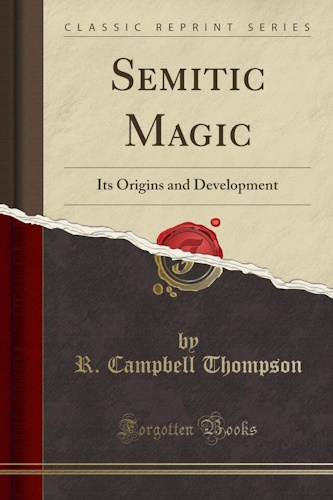

Semitic Magic Its Origins and Development

Excerpt from Semitic Magic Its Origins and Development
The theories put forward or maintained in this book are based on a study of that intricate demonology which has gradually developed throughout the lands of Western Asia. The earliest written records of this magic are found in the cuneiform incantation tablets from Assyria; and, aided by the various stepping-stones afforded by Rabbinic tradition, Syriac monkish writings, and Arabic tales, we can trace its growth and decadence through three thousand years down to its survival in modern Oriental superstition. Furthermore, the parallels afforded by Aryan and Hamitic nations show how close the grooves are in which savage ideas run, and that the principles of magic are, broadly speaking, coincident in each separate nation, and yet, as far as we know, of independent invention. All these superstitions combine to throw light on many of the peculiar customs of the Old Testament, and help to explain the hidden reason why these customs existed. From a study of the characteristics of the evil spirits, which the Semite believed to exist everywhere, certain deductions can be made which bear intimately on our knowledge of the origins of certain tabus and the principle of atonement.
About the Publisher
Forgotten Books publishes hundreds of thousands of rare and classic books. Find more at www.forgottenbooks.com
This book is a reproduction of an important historical work. Forgotten Books uses state-of-the-art technology to digitally reconstruct the work, preserving the original format whilst repairing imperfections present in the aged copy. In rare cases, an imperfection in the original, such as a blemish or missing page, may be replicated in our edition. We do, however, repair the vast majority of imperfections successfully; any imperfections that remain are intentionally left to preserve the state of such historical works.
Paperback: 360 pages
Publisher: Forgotten Books (November 16, 2016)
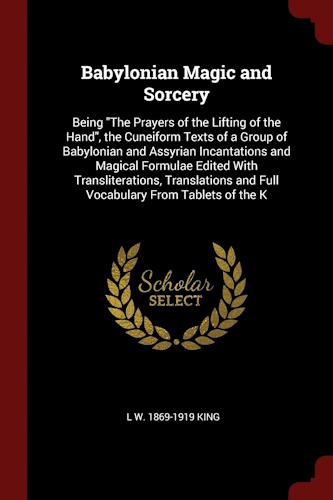

Babylonian Magic and Sorcery: Being "The Prayers of the Lifting of the Hand"

This work has been selected by scholars as being culturally important, and is part of the knowledge base of civilization as we know it. This work was reproduced from the original artifact, and remains as true to the original work as possible. Therefore, you will see the original copyright references, library stamps (as most of these works have been housed in our most important libraries around the world), and other notations in the work.
This work is in the public domain in the United States of America, and possibly other nations. Within the United States, you may freely copy and distribute this work, as no entity (individual or corporate) has a copyright on the body of the work.
As a reproduction of a historical artifact, this work may contain missing or blurred pages, poor pictures, errant marks, etc. Scholars believe, and we concur, that this work is important enough to be preserved, reproduced, and made generally available to the public. We appreciate your support of the preservation process, and thank you for being an important part of keeping this knowledge alive and relevant.
Paperback: 394 pages
Publisher: Andesite Press (August 22, 2017)


"The Hebrew Goddess" demonstrates that the Jewish religion, far from being pure monotheism, contained from earliest times strong polytheistic elements, chief of which was the cult of the mother goddess. Lucidly written and richly illustrated, this third edition contains new chapters of the Shekhina.
Series: Raphael Patai Series in Jewish Folklore and Anthropology
Paperback: 408 pages
Publisher: Wayne State University Press; 3 edition (September 1, 1990)


Lilith's Cave: Jewish Tales of the Supernatural

Once upon a time in the city of Tunis, a flirtatious young girl was drawn into Lilith's dangerous web by glancing repeatedly at herself in the mirror. It seems that a demon daughter of the legendary Lilith had made her home in the mirror and would soon completely possess the unsuspecting girl. Such tales of terror and the supernatural occupy an honored position in the Jewish folkloric tradition.
Howard Schwartz has superbly translated and retold fifty of the best of these folktales, now collected into one volume for the first time. Gathered from countless sources ranging from the ancient Middle East to twelfth-century Germany and later Eastern European oral tradition, these captivating stories include Jewish variants of the Pandora and Persephone myths and of such famous folktales as "The Fisherman and His Wife," "The Sorcerer's Apprentice," and "Bluebeard," as well as several tales from the Middle Ages that have never before been published.
Focusing on crucial turning points in life--birth, marriage, and death--the tales feature wandering spirits, marriage with demons, werewolves, speaking heads, possession by dybbuks (souls of the dead who enter the bodies of the living), and every other kind of supernatural adversary. Readers will encounter a carpenter who is haunted when he makes a violin from the wood of a coffin; a wife who saves herself from the demoness her husband has inadvertently married by agreeing to share him for an hour each day; and the age-old tale of Lilith, Adam's first wife, who refused to submit to him and instead banished herself from the Garden of Eden to give birth to the demons of the world.
Drawn from Rabbinic sources, medieval Jewish folklore, Hasidic texts, and oral tradition, these stories will equally entrance readers of Jewish literature and those with an affection for fantasy and the supernatural.
Paperback: 288 pages
Publisher: Oxford University Press; Reprint edition (December 12, 1991)
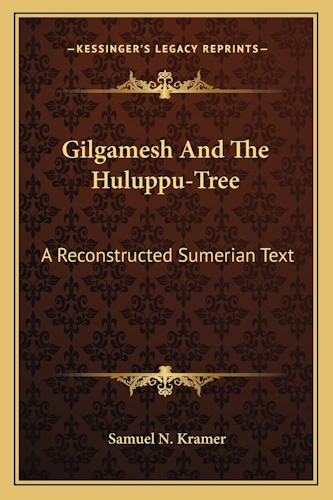

Gilgamesh And The Huluppu-Tree: A Reconstructed Sumerian Text

This scarce antiquarian book is a facsimile reprint of the original. Due to its age, it may contain imperfections such as marks, notations, marginalia and flawed pages. Because we believe this work is culturally important, we have made it available as part of our commitment for protecting, preserving, and promoting the world's literature in affordable, high quality, modern editions that are true to the original work.
Paperback: 72 pages
Publisher: Kessinger Publishing, LLC (September 10, 2010)


Part Six in the Alberto Series. Learn how the papacy helped start Islam, only to have this new daughter rebel against her. You'll understand the Arab's place in Bible prophecy. Muslims have been saved by reading this book. See how Rome guided the development of Islam, only to be double-crossed later. Read how the Virgin Mary is being used to bring that rebellious daughter, Islam, back into cooperation with "Mother Church." The global "super-church" is forming!
Series: Crusader Comics (Book 17)
Single Issue Magazine: 32 pages
Publisher: Chick Pub; Crusader Comic Book Volume 17 edition (February 20, 1986)


It is the reproduction of the original edition published long back in black & white format . Hardcover with sewing binding with glossy laminated multi-Colour Dust Cover, Printed on high quality Paper, professionally processed without changing its contents.We found this book important for the readers who want to know about our old treasure so we brought it back to the shelves. Print on Demand.
Hardcover: 666 pages
Publisher: Isha Books (2013)
![]()
![]()